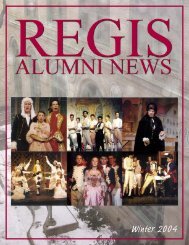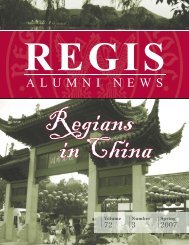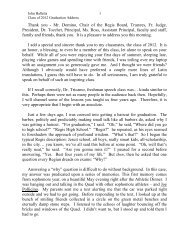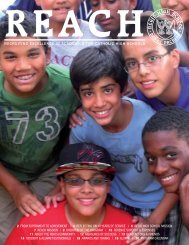Also in this Issue
RAN - Spring 2005 V08.indd - Regis High School
RAN - Spring 2005 V08.indd - Regis High School
- No tags were found...
Create successful ePaper yourself
Turn your PDF publications into a flip-book with our unique Google optimized e-Paper software.
6 Regis Alumni News<br />
REACH<strong>in</strong>g for Success<br />
This Spr<strong>in</strong>g marked the fi rst class of REACH students to apply to high school. Owen Reidy ‘99 sat<br />
down with Father Chris Devron, SJ, the Director of the REACH Program, to chat about the results<br />
and his thoughts on how the REACH program has grown s<strong>in</strong>ce its <strong>in</strong>ception three years ago and<br />
what’s <strong>in</strong> store for the future.<br />
Owen Reidy: When did the REACH program beg<strong>in</strong>?<br />
Chris Devron: REACH (Recruit<strong>in</strong>g Excellence <strong>in</strong> Academics for Catholic High Schools)<br />
began <strong>in</strong> the summer of 2002, with our first class of nearly 40 ris<strong>in</strong>g 6 th graders. But<br />
one could argue that it’s orig<strong>in</strong>s lay <strong>in</strong> the found<strong>in</strong>g mission of Regis itself: to create a<br />
truly outstand<strong>in</strong>g, tuition-free educational opportunity for the sons of the immigrant<br />
Catholic population of New York City, whose families could not otherwise afford a<br />
Catholic education.<br />
OR: What were the reasons for its <strong>in</strong>ception?<br />
CD: Frankly, Regis has long been concerned that its mission is be<strong>in</strong>g compromised by<br />
the <strong>in</strong>equality of educational opportunity that exists on the basis of family <strong>in</strong>come <strong>in</strong><br />
New York City. Probably to no one’s surprise, over the past 25 years, the Regis student<br />
population has become more affluent and more suburban. In numbers proportionate<br />
to their growth <strong>in</strong> New York City’s population, sons of the new wave of Catholic<br />
immigrants—admittedly, of different hues and languages than their Irish and Italian<br />
predecessors—were not w<strong>in</strong>n<strong>in</strong>g Regis scholarships.<br />
It’s <strong>in</strong>terest<strong>in</strong>g to note, for example, that Lat<strong>in</strong>o Catholics now outnumber Anglo<br />
Catholics <strong>in</strong> New York City. In a recent New York Times article about the new African<br />
immigrants, we read that the Nigerian population <strong>in</strong> New York City (many of whom are<br />
Catholic) has exploded by over 100%. These students—and <strong>in</strong> general, students from<br />
lower socio-economic backgrounds—were not grow<strong>in</strong>g <strong>in</strong> our admissions pool <strong>in</strong> the<br />
way we would have liked to see.<br />
Poorer students just weren’t mak<strong>in</strong>g it to the “start<strong>in</strong>g gate”—<strong>in</strong> the case of Regis, the<br />
entrance exam, and satisfactory results on it, which do a pretty good job of predict<strong>in</strong>g<br />
later success. Because race, class and ethnicity do not determ<strong>in</strong>e academic gifts and<br />
talents, we believe the real culprit is the lack of access that low-<strong>in</strong>come students have<br />
to quality elementary school education, that would truly prepare students to compete<br />
for the rigor of a Regis education.<br />
We’ve all been saddened and dismayed by the recent clos<strong>in</strong>g of several parochial<br />
schools <strong>in</strong> Brooklyn, which once educated thousands of future Regians. In a bygone<br />
day, many of these neighborhood <strong>in</strong>stitutions were feeder schools to Regis. But now<br />
the tremendous f<strong>in</strong>ancial pressure on <strong>in</strong>ner-city education, and the great <strong>in</strong>equity of<br />
resources between urban schools (e.g., their <strong>in</strong>ability to reta<strong>in</strong> quality teachers at a<br />
woefully <strong>in</strong>adequate salary; their <strong>in</strong>ability to offer extracurricular programs such as<br />
drama, music and speech and debate; their grow<strong>in</strong>g class size) and those <strong>in</strong> suburban<br />
areas means that academically gifted students from low-<strong>in</strong>come backgrounds do not<br />
currently experience a level play<strong>in</strong>g field.<br />
Tragically, our <strong>in</strong>ner-city pr<strong>in</strong>cipals at the elementary schools tell me that they<br />
simply don’t have the resources to develop their students who have the greatest<br />
academic potential. So those young people sit <strong>in</strong> their desks, bored and distracted,<br />
not <strong>in</strong>tellectually stimulated, and their talents go undeveloped. The story would be<br />
very different if they could attend a top rate school, where they could fully avail<br />
themselves of the opportunities for advanced coursework, and move at a pace equal<br />
to their high potential.<br />
So Regis felt it had to go out and f<strong>in</strong>d these students ourselves, identify them, prepare<br />
them. As Eric DiMichele is fond of say<strong>in</strong>g, we need to “home grow” our own candidates
















